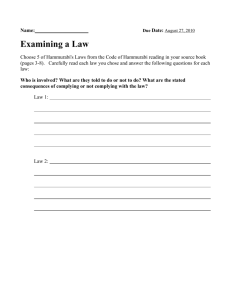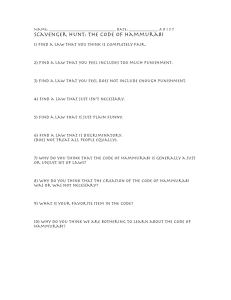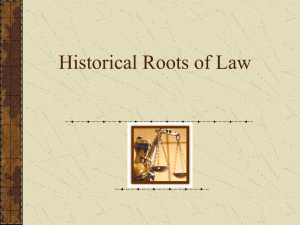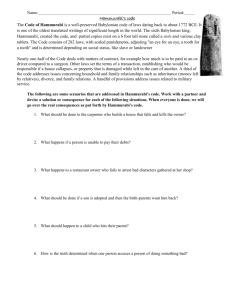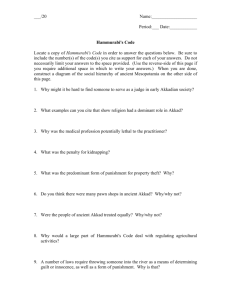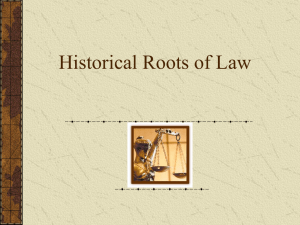Chapter 15 Section 1
advertisement
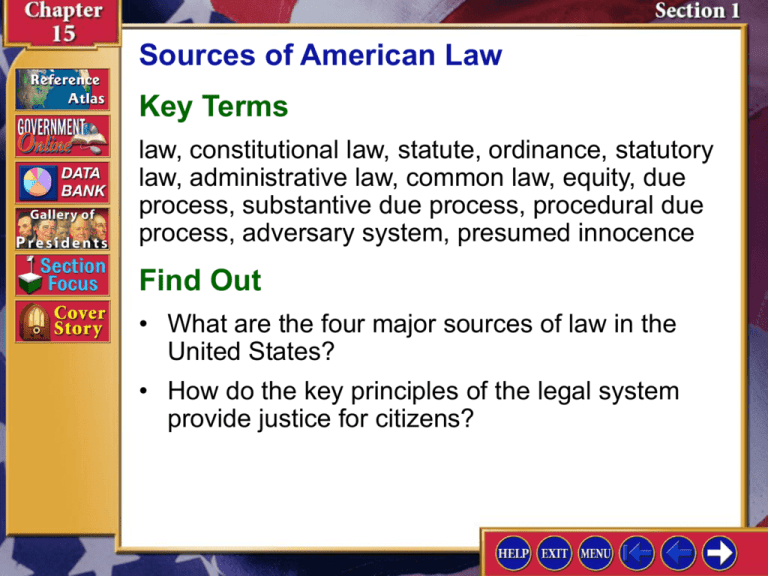
Sources of American Law Key Terms law, constitutional law, statute, ordinance, statutory law, administrative law, common law, equity, due process, substantive due process, procedural due process, adversary system, presumed innocence Find Out • What are the four major sources of law in the United States? • How do the key principles of the legal system provide justice for citizens? Sources of American Law Understanding Concepts Civic Participation Why is understanding the law an important civic responsibility? Section Objective Discuss the major foundations and principles of the American legal system. Justice in the United States is said to be blind. Why? Because in the U.S. legal system, the courts view everyone in the same way. Cartoons often show justice as a young, blindfolded woman who holds an equally balanced scale to weigh evidence. I. Early Systems of Law (pages 423–424) A. The Code of Hammurabi is a collection of laws assembled by Hammurabi, king of Babylon from 1792 to 1750 B.C. B. The Ten Commandments are rules found in the Old Testament of the Bible, the source of law for people of several major religions. I. Early Systems of Law (pages 423–424) What was the Code of Hammurabi made up of? The code was made up of 282 legal cases that spelled out relationships among individuals as well as punishments in areas that are now considered property law, family law, civil law, and criminal law. II. Our Legal Heritage (pages 424–426) A. Constitutional Law: 1. is the fundamental source of U.S. law; is the supreme law of the land; applies to everyone. 2. follows from state constitutions (adopted 1776 to 1780); decides the limits of government’s power and the rights of the individual; may deal with either criminal or civil law. II. Our Legal Heritage (pages 424–426) B. Statutory Law: 1. is written by a legislative branch of government; 2. limits people’s behavior but also grants rights and benefits; 3. comprises many federal court decisions and about one-fifth of all Supreme Court cases; 4. is sometimes called Roman law, since like laws of ancient Rome, statutory law is written down so that all may know the law. II. Our Legal Heritage (pages 424–426) C. Administrative Law: 1. spells out the authority and procedures to be followed by federal agencies; 2. sets rules and regulations issued by those agencies. D. The Common Law: 1. is the most important basis of the legal system; is made by judges in the process of settling individual cases; began in England and then spread to the colonies. 2. is the basis for state constitutions and the U.S. Constitution. II. Our Legal Heritage (pages 424–426) Except in Louisiana, where legal procedures are based on the Napoleonic Code, most states still follow common law. Why did common law become a part of the American system of laws? English colonists brought common law with them to America. III. Legal System Principles (pages 427–428) A. Equal justice under the law refers to the goal of the American court system to treat all persons alike and grant them the full protection of the law. B. Due process of law guarantees constitutional rights and requires that persons be informed of pending government legal action and then given the right to respond or be heard. III. Legal System Principles (pages 427–428) C. The adversary system in American courts allows lawyers for opposing sides to present their strongest cases. D. Presumption of innocence means persons accused of crimes are presumed innocent until proven guilty; the burden of proof falls on the prosecution. III. Legal System Principles (pages 427–428) Which of the four principles that underlie the operation of the American legal system do you think is the most important? Answers will vary among equal justice, due process, adversary system, and presumption of innocence. Checking for Understanding 1. Main Idea In a graphic organizer, identify the major sources of American law and the key principles of the American legal system. Sources: United States Constitution, statutory law, administrative law, common law; principles: rule of law, equal justice under the law, due process, adversary system, presumed innocence. Checking for Understanding Match the term with the correct definition. ___ E law ___ D statute ___ F ordinance ___ A equity A. a system of rules by which disputes are resolved on the grounds of fairness B. law made by the judges in the process of individual cases ___ C adversary system C. a judicial system in which opposing lawyers present their strongest cases ___ B common law D. a law written by a legislative branch E. set of rules and standards by which a society governs itself F. a law Checking for Understanding 3. Identify Code of Hammurabi, Justinian Code, precedent, “equal justice under the law.” The Code of Hammurabi was a collection of laws assembled by Hammurabi, king of Babylon. The Justinian Code was the Roman legal code organized by the Roman emperor Justinian. A precedent is a model on which to base later decisions or actions. “Equal justice under the law” refers to the goal of the American court system to treat all persons equally. Critical Thinking 4. Identifying Alternatives Permitting rental agencies to refuse to rent apartments to families with children would violate what kind of due process? As an unreasonable regulation, it would violate substantive due process. Civic Participation Laws affect nearly everything people do. Laws change to meet the needs of the times. Work with a partner to either brainstorm new laws or identify laws that should be repealed. Create and present a skit showing a situation that requires a new law to be established or an existing law to be repealed.
